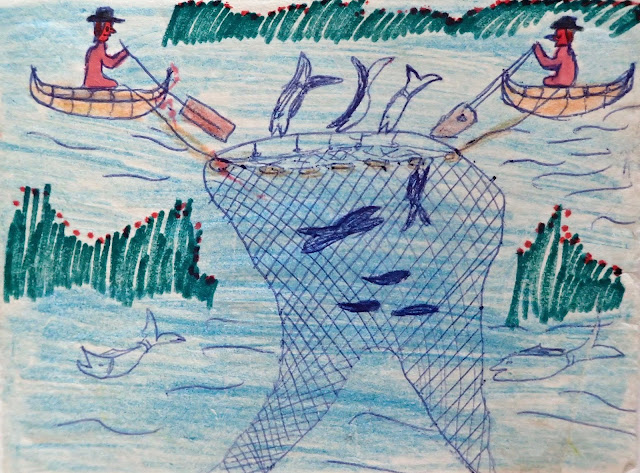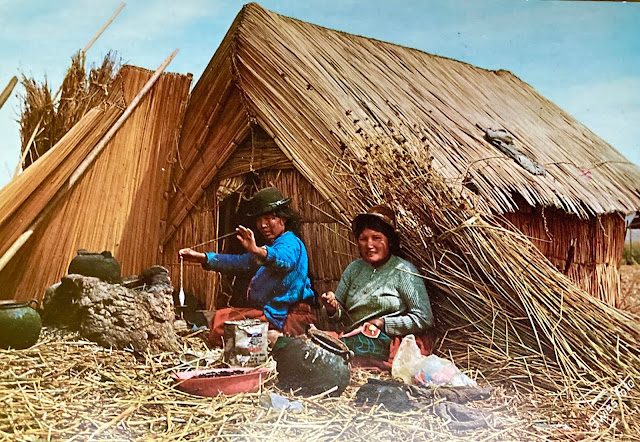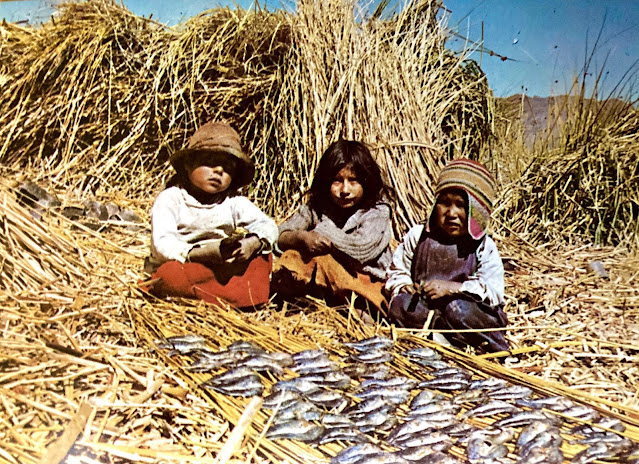Puno and Lake Titicaca, Peru June 9, 1979
A longish train trip yesterday through relatively desolate altiplano, unfortunately made with no food. Kept thinking the vendadores would come through with their baskets of empanadas, choclos and tamales, but apparently they were not permitted in ‘first class’, and the only ones who managed to break through were selling alpaca goods, popcorn, chocolates or huge bags of bread which they refused to open to sell only one… .
We arrived in Puno after a very long, cold, dark wait in Juliaca, where the train was shunted around an uncountable number of times. For once I was glad for the gangs of little boy touts who frequent the bus and train stations, leading tourists to local hotels. We followed one to the Lima Hotel, and then to a restaurant where we had a fantastic dinner of curried fish soup and ‘crema de leche’ – a whipped, light cream with lemon and sugar, mousse-like and heavenly. Then took a short digestive stroll around town – not much to see here – and went to bed.
This morning we walked through the central plaza, where there was a sitting statue of the Incan God Manco Kapak. He was wearing colourful dress (not pants) with a fabulous headdress and a very tall axe-like ceremonial(?) staff. I particularly liked his sandals and the smiling, golden, sun-god face on his chest. I didn’t see anyone praying to him and I haven’t heard of Manco Kapak before, so perhaps he’s a local god-figure.
From there down to the edge of the lake to ask about boats to Taquile Island, which is almost in the middle of the lake. We managed to book one for tomorrow, and then were persuaded to go on a trip to the ‘floating islands’, which turned out to be fabulous. A launch took a group of us about an hour out into the lake, through beautiful beds of tortura reeds. I enjoyed the illusion of no horizon created by the sharpness of the reflections on the surface of the incredibly still water – not so much as a riplet on this big open lake.
Obviously there are ripples in this photo! But that was later....
Spluttering along, our boat held a steady course through the reeds, following wide paths carved out through frequent use. Every so often a narrower branch trail, heading off to some small floating island, someone’s home. We drifted into three of these branches and came to small settlements where houses were made of reeds, and the people, Urus, offered up miniature reed boats and brightly coloured embroidered cloths with images of daily life, birds and animals. The kids got into the act, selling miniature ceramic pots and dishes – doll’s dishes – and coloured drawings. I bought two drawings.
The relative poverty and the incredible hardship of their lives was obvious, and yet the people seemed very serene, and serious looking to the point of solemnity. The adults carried on with whatever they were doing, paying us not much attention, while the kids begged for chocolate. They were all quite shy, giggling and covering their mouths with their hands when we talked to them. But a little girl of 7 or 8, bargained hard with me over a piece of embroidery. She had her sales pitches down pat, and ended up getting her price. I was glad to give it to her. Her self-confidence and determination were inspirational.
Floating Island images:
- A woman in her many-layered skirt, the outermost, as is the custom here, neon red, pink, orange or electric green – for her it was pink – waddle-walking across a particularly soft spot on the island, sinking to mid-calf in the reed-water muck, but carrying duck-like on, her youngest on her back, and another little pink-and-green-clad waif trailing along behind, sinking into the muck not quite so far, but far enough to be using the peculiar bow-legged duck-walk learned, no doubt, from its parents.
- An elderly women in black – no day-glo colours for her, perhaps a more traditional soul – sitting in the shade of a reed lean-to. Beside her a young woman in red and orange nursing a child of perhaps one or two. And beside her a third woman, middle-aged, holding a huge grinding stone in both hands, rocking it back and forth on a rectangular stone slab-bowl, its wide lip about an inch higher than surface of the bowl surface, grinding grains of wheat or? into a coarse flour.
- A little girl in a tattered hot pink dress and huge bowler hat, running barefoot across the crushed reed surface of the island, sneaking peaks at the gringos.
- Another little girl, fishing in the lake with a little group of kids, suddenly screaming for her mama when an overly-friendly, culturally and socially ignorant gringo picks her up and holds her aloft, posing for a photo-op. (Sigh, cringe.)
- A few new aluminum huts, some ‘faced’ with tortura reeds some left brazenly uncovered, their shining surfaces standing out against the dull browns of the island reeds, reflecting the bright, unforgiving glare of the Lake Titicaca sun.
- The quietness of it all, and the stark simplicity of these islanders lives – tortura, fish and whatever they can get from the mainland, which is five to six hours away in their little reed boats, and sometimes a perilous journey, or impossible (the one hour trip by motorized launch costs 300-600 soles, surely an amount well out of reach of the islanders – do they get a special break?
- The ‘new’ Adventist school-cum-religious-centre, thanks to which, I suppose, we can communicate at least with the kids (the adults speak only Ayamara and a smattering of Quechua, but no Spanish).
And for me the over-riding questions of how these people came to live here, and what their lives are like….
Back in town there was a parade going on. The first contingent was a large group of people in absolutely amazing – huge bell skirts, heavily appliqued and embroidered with colourful designs, topped by big circular ruffled collars, also heavy with designs. Most of the participants wore masks – some of animals, some of people – and headdresses with horns, long green, red or white feathers. Almost all wore long white gloves. I was told that the costumes were the indigenous peoples’ fanciful representation of the Spanish conquistadors. That seemed possible. Anyway after this group came a group of musicians, mostly playing pan flutes. They wore white pants, and blue long-sleeve shirts, with large cake-like tiered, colourful beaded ‘epaulets’ (well, shoulder pieces) with dangling fringes on their shoulders. Their hats were red or green with big brims and a fringe of dangling white bobbles. And then came the piece-de-resistance – a huge statue of the Virgin Mary, in a flowing blue and fold cape, holding the baby Jesus. She was held aloft on a trestle, by eight men, also in costume. When I saw her I wondered if the elaborate costumes were more a representation of Catholic church figures.
The parade stopped near the central square and there was a bit of a performance, but I was unable to follow what was being portrayed. And who was the fellow with the black face, in a white shirt and tie with a tight-fitting corset-like vest? Of course in the end it didn’t matter. It was fun just to see it.





















Comments
Post a Comment